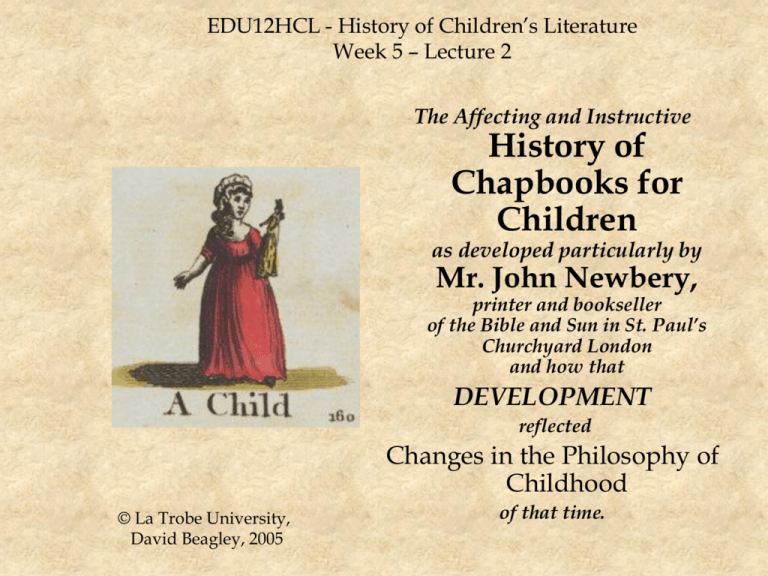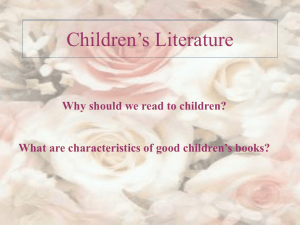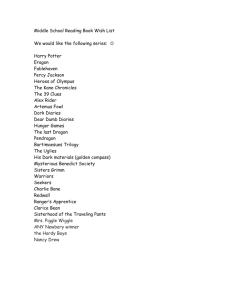Lecture 2 - The Invention of Childhood
advertisement

EDU12HCL - History of Children’s Literature Week 5 – Lecture 2 The Affecting and Instructive History of Chapbooks for Children as developed particularly by Mr. John Newbery, printer and bookseller of the Bible and Sun in St. Paul’s Churchyard London and how that DEVELOPMENT reflected Changes in the Philosophy of Childhood © La Trobe University, David Beagley, 2005 of that time. Support resources • La Trobe Children’s Literature web site http://www.latrobe.edu.au/childlit • Heyward Library - Reserve - texts and critical studies • Heyward Library Subject Guides http://www.lib.latrobe.edu.au/help/subjectres/ben/childlit.php • Heyward Library databases - individually or LibXplore AustLit, AEI, ALISA, AustGuide - Australian Eric, Proquest, Project Muse, MLA - overseas Defining Children’s Literature For there to be Children’s Literature, there must be: • Children • Literature • Children – the concept of childhood, the recognition that children have needs, interests and capacities that are different to adults • Literature – the conscious creation of literary material specifically for those needs, interests and capacities. References Townsend, J.R. (1996) Written for Children: an outline of English-Language Children’s Literature. 6th ed. London: Scarecrow Press. (“Part One: before 1840”) Jackson, M. (1989) Engines of Instruction, Mischief and Magic: children’s literature in England from its beginnings to 1839. Lincoln: University of Nebraska Press Shavir, Z. (1986)The poetics of Children’s Literature [online] Chap. 1 The notion of childhood and texts for the child Chap. 7. Stratification of a system. Available: http://tau.ac.il/~zshavit/pocl/seven.html University of Pittsburgh (2005) The Elizabeth Nesbitt Room Chapbook Collection [online] Available: http://www.library.pitt.edu/libraries/is/enroom/ John Newbery 1713-1767 The first successful commercial publisher for children • Son of a farmer • Became owner of a printing business in his 20s by marrying the widow of the previous owner • Moved to London 1743, • Published A Little Pretty Pocket Book in 1744 • Aimed at newly prosperous middle class and their values John Newbery 1713-1767 Recognized several important commercial points: • Must appeal to the child • But do not contradict the values of the parent • Included giveaways and special offers – e.g. ball, pincushion, free editions from his shop – with apparent educational or benevolent purpose • Constant and regular “penetration” of the market – build expectations of audience, and brand loyalty • Have pictures John Newbery 1713-1767 • Also sold patent medicines – Dr James Fever Powder – and used the books to promote it • Mixed the audiences and “hooks” astutely – adventure and fantasy to interest the children, morals and education to please the parents • Established and kept reputation for enthusiasm and best interests of children • Mixed with leading literary figures • USA’s Children’s Book of the Year award is the Newbery Medal Goody Two Shoes Goody Two Shoes • Typical mixture of fantastic adventure and moral lessons • Bit of “Shrek”-like tongue in cheek attribution – See the original manuscript in the Vatican at Rome, and the cuts by Michael Angelo • Story drew on Cinderella (prohibited for a time) and was adapted by other authors, even for adults The idea of a child • Children traditionally viewed as “little adults” • Survival problems - infant mortality rate, economic survival etc. • Philosophy and definition - the big change postRenaissance/Reformation: • Adam vs Baby Jesus - the child is the “Pure form” of a person • Adam - the essential sinner, the natural tendency to “go bad”, has to be dragged back to the Good, conscious choices • Baby Jesus - essentially innocent, natural tendency to joy and play, has to be protected from Evil, gradual training The idea of a child 1693: John Locke’s Thoughts concerning Education The mind at birth is a blank page upon which the lessons of life are to be impressed. Therefore, a child … • Has a distinctive nature that is NOT adult • Has a need for protection against the evils of the world • Has a need for nurture and support • Should be gradually trained, and allowed to discover • Should be allowed a time for innocent joys and play Thus, children’s literature … • Should be different to adult literature • Should reflect those elements of a child and childhood: innocence and joy, protection and nurture, gradual learning • So Newbery’s, and the other early books, mix childish fantasy (often drawn from folk and fairy tales) serious moralising (as warning and teaching) dressed up in a format designed for “little” readers: size, pictures, language, giveaways, etc. Little Red Riding Hood Compare Perrault’s “Little Red Riding Hood” and Grimm’s “Rotkäppchen” • Perrault (late 1600s) • Written for adults, ambiguous and ironic tone, RRH’s beauty emphasised, subtle jokes, “sad” ending • Clear sexual tone and warnings - wolf in bed - RRH is convinced to join him - is eaten • Theme of seduction of young girls - who is the audience who should learn: the seducer or the girl? Little Red Riding Hood • Grimms (early 1800s) • Written for both adults and children - much simpler expression, RRH’s innocence and nature emphasised, child-like actions and decisions, happy ending • Sexual implications removed - wolf is animal rather than anthropomorphic - dresses in Grandma’s clothes • Theme is warning for children - obey your parents, beware of strangers, adults will be there to protect you.











